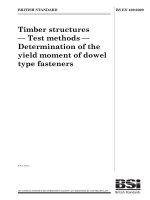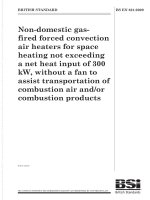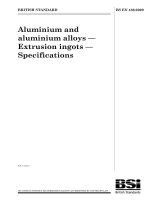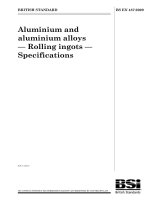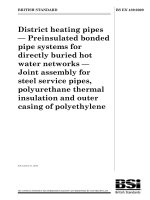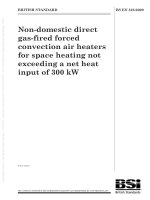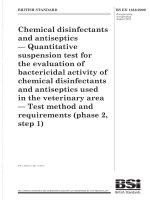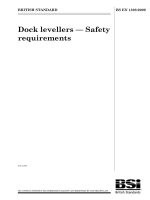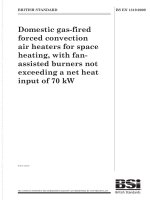Bsi bs en 62192 2009
Bạn đang xem bản rút gọn của tài liệu. Xem và tải ngay bản đầy đủ của tài liệu tại đây (1005.83 KB, 26 trang )
BS EN 62192:2009
BSI Standards Publication
Live working — Insulating ropes
BRITISH STANDARD
BS EN 62192:2009
National foreword
This British Standard is the UK implementation of EN 62192:2009. It is
identical to IEC 62192:2009.
The UK participation in its preparation was entrusted to Technical Committee
PEL/78, Tools for live working.
A list of organizations represented on this committee can be obtained on
request to its secretary.
This publication does not purport to include all the necessary provisions of a
contract. Users are responsible for its correct application.
© BSI 2010
ISBN 978 0 580 57283 8
ICS 13.260; 29.240.20; 29.260.99
Compliance with a British Standard cannot confer immunity from
legal obligations.
This British Standard was published under the authority of the Standards
Policy and Strategy Committee on 31 May 2010.
Amendments issued since publication
Amd. No.
Date
Text affected
BS EN 62192:2009
EUROPEAN STANDARD
EN 62192
NORME EUROPÉENNE
EUROPÄISCHE NORM
June 2009
ICS 13.260; 29.240.20; 29.260.99
English version
Live working Insulating ropes
(IEC 62192:2009)
Travaux sous tension Cordes isolantes
(CEI 62192:2009)
Arbeiten unter Spannung Isolierende Seile
(IEC 62192:2009)
This European Standard was approved by CENELEC on 2009-05-01. CENELEC members are bound to comply
with the CEN/CENELEC Internal Regulations which stipulate the conditions for giving this European Standard
the status of a national standard without any alteration.
Up-to-date lists and bibliographical references concerning such national standards may be obtained on
application to the Central Secretariat or to any CENELEC member.
This European Standard exists in three official versions (English, French, German). A version in any other
language made by translation under the responsibility of a CENELEC member into its own language and notified
to the Central Secretariat has the same status as the official versions.
CENELEC members are the national electrotechnical committees of Austria, Belgium, Bulgaria, Cyprus, the
Czech Republic, Denmark, Estonia, Finland, France, Germany, Greece, Hungary, Iceland, Ireland, Italy, Latvia,
Lithuania, Luxembourg, Malta, the Netherlands, Norway, Poland, Portugal, Romania, Slovakia, Slovenia, Spain,
Sweden, Switzerland and the United Kingdom.
CENELEC
European Committee for Electrotechnical Standardization
Comité Européen de Normalisation Electrotechnique
Europäisches Komitee für Elektrotechnische Normung
Central Secretariat: Avenue Marnix 17, B - 1000 Brussels
© 2009 CENELEC -
All rights of exploitation in any form and by any means reserved worldwide for CENELEC members.
Ref. No. EN 62192:2009 E
BS EN 62192:2009
–2–
EN 62192:2009
Foreword
The text of document 78/773/FDIS, future edition 1 of IEC 62192, prepared by IEC TC 78, Live working,
was submitted to the IEC-CENELEC parallel vote and was approved by CENELEC as EN 62192 on
2009-05-01.
The following dates were fixed:
– latest date by which the EN has to be implemented
at national level by publication of an identical
national standard or by endorsement
(dop)
2010-02-01
– latest date by which the national standards conflicting
with the EN have to be withdrawn
(dow)
2012-05-01
Annex ZA has been added by CENELEC.
__________
Endorsement notice
The text of the International Standard IEC 62192:2009 was approved by CENELEC as a European
Standard without any modification.
In the official version, for Bibliography, the following note has to be added for the standard indicated:
IEC 60743 + A1
NOTE Harmonized as EN 60743:2001 + A1:2008 (not modified).
__________
BS EN 62192:2009
EN 62192:2009
–3–
Annex ZA
(normative)
Normative references to international publications
with their corresponding European publications
The following referenced documents are indispensable for the application of this document. For dated
references, only the edition cited applies. For undated references, the latest edition of the referenced
document (including any amendments) applies.
NOTE When an international publication has been modified by common modifications, indicated by (mod), the relevant EN/HD
applies.
Publication
Year
1)
Title
EN/HD
Year
High-voltage test techniques Part 1: General definitions and test
requirements
HD 588.1 S1
1991
2)
IEC 60060-1
-
IEC 60212
1971
HD 437 S1
Standard conditions for use prior to and
during the testing of solid electrical insulating
materials
1984
IEC 60417
Database
Graphical symbols for use on equipment
-
-
IEC 61318
2007
Live working - Conformity assessment
applicable to tools, devices and equipment
EN 61318
2008
IEC 61477
-
1)
Live working - Minimum requirements for the EN 61477
utilization of tools, devices and equipment
2009
2)
ISO 2307
-
1)
Fibre ropes - Determination of certain
physical and mechanical properties
2005
2)
1)
2)
Undated reference.
Valid edition at date of issue.
EN ISO 2307
BS EN 62192:2009
–2–
62192 IEC:2009
CONTENTS
INTRODUCTION.....................................................................................................................5
1
Scope ...............................................................................................................................6
2
Normative references .......................................................................................................6
3
Terms and definitions .......................................................................................................6
4
Requirements ...................................................................................................................7
4.1
5
Physical and dimensional ........................................................................................7
4.1.1 Physical.......................................................................................................7
4.1.2 Dimensional ................................................................................................7
4.2 Electrical .................................................................................................................7
4.3 Mechanical ..............................................................................................................7
4.4 Marking ...................................................................................................................8
4.5 Instructions for use and care ...................................................................................8
Tests ................................................................................................................................9
5.1
5.2
5.3
6
General ...................................................................................................................9
Atmospheric conditions ...........................................................................................9
Visual verification and dimensional checking ...........................................................9
5.3.1 Visual verification ........................................................................................9
5.3.2 Dimensional check ......................................................................................9
5.4 Electrical tests.........................................................................................................9
5.4.1 Leakage current under dry conditions ..........................................................9
5.4.2 Tests after water conditioning .................................................................... 13
5.5 Mechanical tests ................................................................................................... 14
5.5.1 Water absorption ....................................................................................... 14
5.5.2 Capillary .................................................................................................... 14
5.5.3 Elongation and creep................................................................................. 14
5.6 Durability of marking ............................................................................................. 15
5.7 Verification of the required instructions for use ...................................................... 15
Conformity assessment of insulating ropes having completed the production phase ....... 15
7
Modifications .................................................................................................................. 15
Annex A (normative) Suitable for live working; double triangle (IEC 60417-5216
(2002-10))............................................................................................................................. 16
Annex B (normative) Chronology of type tests ..................................................................... 17
Annex C (normative) Classification of defects ...................................................................... 18
Annex D (informative) Recommendations for in-service care and periodic testing ................ 19
Bibliography.......................................................................................................................... 21
Figure 1 – Example of test set up to measure leakage current .............................................. 10
Figure 2 – Electrode arrangement on rope test piece ............................................................ 12
Table B.1 – Chronology of type tests .................................................................................... 17
Table C.1 – Classification of defects and associated requirements and tests ........................ 18
BS EN 62192:2009
62192 IEC:2009
–5–
INTRODUCTION
Insulating ropes designed and manufactured according to this standard contribute to the
safety of the users, provided they are used by skilled persons, in accordance with safe
methods of work and the instructions for use.
This International Standard defines the required electrical properties of insulating ropes which
already meet other specifications relating to mechanical strength, physical and construction
properties, for use in live working at the power frequency system voltages up to and including
800 kV r.m.s.
This standard does not propose to address all the safety factors associated with the use of
the insulating rope. It is the responsibility of the user to establish appropriate safety practices.
Ropes which meet this standard can bridge two or more live phase conductors, or one phase
conductor and earth as required during live working. Effects of the use of insulating ropes on
the dielectric strength of the installation have to be evaluated. Depending on the configuration
of an installation, the use of insulating ropes will have different effects on its dielectric
strength.
Cotton, sisal and hemp ropes are unsuitable for this application, as are any other ropes that
exhibit electrical conductivity. Examples of ropes which are able to meet the requirements of
this standard are formed from fibres that have been treated with a wax or other chemical
which causes the surface of the rope to become hydrophobic.
This document has been prepared according to the requirements of IEC 61477 where
applicable.
The product covered by this standard may have an impact on the environment during some or
all stages of its life cycle. These impacts can range from slight to significant, be of short-term
or long-term, and occur at the global, regional or local level.
Except for a requirement for the selection of a testing dye and the disposal statement in the
instructions for use, this standard does not include requirements and test provisions for the
manufacturers of the product, or recommendations to the users of the product for
environmental improvement. However, all parties intervening in its design, manufacture,
packaging, distribution, use, maintenance, repair, reuse, recovery and disposal are invited to
take account of environmental considerations.
BS EN 62192:2009
–6–
62192 IEC:2009
LIVE WORKING –
INSULATING ROPES
1
Scope
This International Standard covers insulating ropes that are utilized during live working
procedures in contact with parts of installations operating at voltages up to and including
800 kV r.m.s.
Insulating ropes for live working procedure under rain and/or d.c. conditions are not covered
by this standard.
2
Normative references
The following referenced documents are indispensable for the application of this document.
For dated references, only the edition cited applies. For undated references, the latest edition
of the referenced document (including any amendments) applies.
IEC 60060-1, High-voltage test techniques – Part 1: General definitions and test requirements
IEC 60212:1971, Standard conditions for use prior to and during the testing of solid electrical
insulating materials
IEC 60417, Graphical symbols for use on equipment
IEC 61318:2007, Live working – Conformity assessment applicable to tools, devices and
equipment
IEC 61477, Live working – Minimum requirements for the utilization of tools, devices and
equipment
ISO 2307, Ropes – Determination of certain physical and mechanical properties
3
Terms and definitions
For the purposes of this document, the terms and definitions given in IEC 61318 and the
following apply.
3.1
creep
dimensional change with time in a test section of the rope when subjected to continued
working load
3.2
elongation
initial dimensional change in a test section of the rope subjected to rated working load for a
short period of time
BS EN 62192:2009
62192 IEC:2009
–7–
3.3
insulating rope
rope with electrical insulating properties suitable for use in contact with live parts
[IEV 651-09-01, modified]
3.4
rope
stout cord made from woven or twisted insulating or non-insulating material used for various
handling operations
NOTE Ropes, which may come into contact with live conductors, should be insulating. Ropes used to move tools
and other equipment into place, which are clear of live parts, may be non-insulating.
[IEC 60743, definition 10.1.1, modified]
4
Requirements
4.1
4.1.1
Physical and dimensional
Physical
Ropes shall be free of visual manufacturing defects such as incorrect impregnation or faulty
stranding or cabling.
Ropes covered by this standard shall demonstrate low water absorption and capillary action.
4.1.2
Dimensional
Diameter and circumference of ropes shall comply with the manufacturer specifications with a
tolerance of ± 10 %.
NOTE
National or regional standards could specify dimensioning where needed.
4.2
Electrical
Ropes covered by this standard shall have appropriate dielectric properties under dry
conditions and when exposed to humid conditions.
Splicing of insulating ropes shall be possible, whilst keeping the ropes appropriate dielectric
properties and in accordance with the manufacturer’s instructions.
Insulating ropes to be used under rain condition, or d.c. stress are not covered by this
standard.
4.3
Mechanical
In addition to other specifications related to mechanical strength and construction properties,
ropes covered by this standard shall demonstrate limit elongation under normal loading
conditions.
BS EN 62192:2009
–8–
62192 IEC:2009
Marking
4.4
The insulating ropes shall be properly identified.
Ropes covered by this standard shall be marked with the following permanent items of
marking:
–
name of the manufacturer, or trade mark,
–
year of manufacture, coded with a colour tracer or other means.
The following information shall also be supplied, either by a marking or other means on the
rope or on each reel of rope or each smallest shipping container:
–
symbol IEC 60417-5216 (2002-10) – Suitable for live working; double triangle (see
Annex A),
NOTE The exact ratio of the height of the figure to the base of the triangle is 1,43. For the purpose of
convenience, this ratio can be between the values of 1,4 and 1,5.
–
number of the relevant IEC standard immediately adjacent to the symbol with year of
publication (four digits) (IEC 62192:2009),
–
batch number,
–
details of diameter,
–
type of lay,
–
fibre material,
–
minimum breaking force,
–
creep,
–
recommended working load.
The marking shall be durable, clearly visible and legible to a person with normal or corrected
vision without additional magnification.
4.5
Instructions for use and care
Each reel of rope or each smallest shipping length shall be supplied with the manufacturer’s
written information and instructions for use and care. These instructions shall be prepared in
accordance with the general provisions given in IEC 61477.
The information and instructions shall include as a minimum:
–
any special treatment of the fibres which makes them specially suitable for this
application,
–
instructions for splicing,
–
instructions for handling, cleaning, storage and transportation,
–
instructions for periodic testing, repair, and disposal of the rope,
–
period of years from the moment of production in which the mechanical characteristics
can be guaranteed (storage life).
BS EN 62192:2009
62192 IEC:2009
5
–9–
Tests
5.1
General
The present standard provides testing provisions to demonstrate compliance of the product to
the requirements of Clause 4. These testing provisions are primarily intended to be used as
type tests for validation of the design input. Where relevant, alternative means (calculation,
examination, tests, etc.) are specified within the test subclauses, for the purpose of insulating
ropes having completed the production phase.
Each type test shall be carried out on test pieces as specified below. If one or more test
pieces fail during the type test, the product has not met the requirements of this standard.
The type tests shall be performed according to the chronological order specified in Annex B.
5.2
Atmospheric conditions
Unless otherwise stated, the lengths of insulating rope submitted to type tests shall be
preconditioned for 4 h ± 0,5 h and tested under the normal atmospheric conditions provided in
Table I of IEC 60212, at a temperature of between 15 °C and 35 °C, with a relative humidity
between 25 % and 75 % (taking into account Note 5 of Table I of IEC 60212).
5.3
Visual verification and dimensional checking
Visual verification
5.3.1
Ropes shall be visually verified to check if the requirements of 4.1.1 and 4.4 are fulfilled.
When visual verification is specified, it shall be understood to be visual verification by a
person with normal or corrected vision without additional magnification.
Dimensional check
5.3.2
Nominal diameter and nominal circumference of ropes shall be measured to check for
compliance with 4.1.2.
5.4
Electrical tests
Unless otherwise specified, the electrical tests shall be carried out in accordance with
IEC 60060-1.
A total of six test pieces are required for the electrical tests.
5.4.1
5.4.1.1
Leakage current under dry conditions
General
The test shall be performed on three test pieces with a length of 2 000 mm each. A voltage of
100 kV r.m.s. shall be applied, across a 300 mm length of rope for 1 min and the leakage
current during this period shall be measured (see Figure 1 for example of a test set-up).
BS EN 62192:2009
– 10 –
62192 IEC:2009
1
100 kV r.m.s.
R
M
2
3
IEC 267/09
Key
1
Test piece
2
Shielded wire
3
Faraday box. A shielded container enclosing and guarding the resistor R and the voltmeter M. Both
the screen and the shield of the measuring lead by-pass R and M, by providing a path for stray
capacitive currents to ground.
R
A 100 Ω, 50 W wirewound non-inductive resistor is recommended. A 50 W resistor at a minimum is
recommended because a hazardous condition would exist if the resistor should fail and create an
open circuit.
M
Battery operated, true RMS, solid state voltmeter
Figure 1 – Example of test set up to measure leakage current
5.4.1.2
Test procedure
The test piece shall be mounted in the vertical position with a distance of 1 500 mm between
the attachment points, and tensioned at the lower attachment point with a 4,5 kg mass.
Two electrodes shall be formed by wrapping tinned copper wire of a diameter between
0,5 mm and 1 mm tightly around the test piece. The electrodes shall be centred in the test
section with a clearance of 300 mm between the electrodes and mounted to provide a good
electrical contact. Figure 2 illustrates the connection.
BS EN 62192:2009
62192 IEC:2009
– 11 –
Dimensions in millimetres
600
A
T = 300
1 500
B
600
C
D
K
IEC 268/09
Figure 2a – Electrode arrangement for test before water conditioning
BS EN 62192:2009
– 12 –
62192 IEC:2009
Dimensions in millimetres
300
A
1 500
T = 600
B
600
C
D
K
IEC 269/09
Figure 2b – Electrode arrangement for test after water conditioning
Key
A
Rope attachment point (bracket parallel jaw or equivalent)
B
High voltage electrode
C
Low voltage electrode
D
Weight attachment point
K
Mass 4,5 kg
T
Test length
Figure 2 – Electrode arrangement on rope test piece
A power frequency voltage of 100 kV shall be applied to the upper electrode and the lower
electrode shall be connected to earth through a micro-ammeter. The voltage shall be raised to
100 kV in a 15 s to 30 s interval and maintained at 100 kV for a period of 1 min. After 1 min,
the voltage shall be decreased to zero in not more than 5 s.
The leakage current shall be measured during the 1 min exposure to the 100 kV voltage.
BS EN 62192:2009
62192 IEC:2009
– 13 –
Test criteria
5.4.1.3
The leakage current test under dry conditions shall be considered as passed if
–
the maximum leakage current is stable and does not exceed 100 μA (0,1 mA) at the
end of the 1 min,
–
during the test, the rope does not initiate a flashover, and
–
at the end of test, the rope does not show burn marks or other signs of damage after a
visual verification.
If the current is fluctuating more than 10 μA at the end of 1 min, and the leakage current has
not exceeded 100 μA and there has been no flashover, the test shall be continued for an
additional 5 min. If at the end of that time the rope has not flashed over and the current has
stabilized at less than 100 μA the test shall be considered as passed.
5.4.2
Tests after water conditioning
The tests shall be performed on three other test pieces with a length of 2 000 mm each.
5.4.2.1
Conditioning
Before the tests, the test pieces shall be kept submerged for a period of 15 min in water
having a resistivity of (100 ± 15) Ω·m.
5.4.2.2
5.4.2.2.1
Leakage current after water conditioning
Test set-up
Within 1 min after removal from the wetting tank, a mass of 4,5 kg shall be attached to the
test piece below the lower electrode to facilitate the parting of any fibres that become
weakened by electrical activity. The test piece shall be allowed to dry for 15 min in
atmospheric conditions as specified in 5.2. Two electrodes shall be formed 600 mm apart by
wrapping tinned copper wire of a diameter between 0,5 mm and 1 mm tightly around rope.
A power frequency voltage of 100 kV r.m.s. shall be applied to the upper electrode, and the
lower electrode shall be connected to earth through a micro-ammeter. See Figures 1 and 2.
5.4.2.2.2
Electrical test procedure and criteria
The voltage shall be raised from 0 kV to 100 kV in not less than 15 s nor more than 30 s.
When reached, the voltage of 100 kV r.m.s. shall be maintained for 5 min. After 5 min, the
voltage shall be decreased to zero in not more than 5 s.
The test shall be considered as passed if
–
the measured leakage current does not exceed 500 μA r.m.s. after 1 min and by the end
of the test is below 250 μA r.m.s., and
–
at the end of the test the insulating rope shows no burn marks or other signs of damage
after a visual verification.
5.4.2.3
Mechanical test after water conditioning
Following the electrical test, the mechanical strength of the same test pieces shall be
determined by measuring the breaking strength according to ISO 2307.
The test shall be considered as passed if the mechanical strength meets manufacturer
specification for the particular type of construction.
BS EN 62192:2009
– 14 –
5.5
62192 IEC:2009
Mechanical tests
A minimum of three test pieces are required for the mechanical tests.
5.5.1
Water absorption
A rope test piece of a minimum length of 1,5 m shall be conditioned by immersing it for 24 h ±
1 h in water at 23 °C ± 2 °C.
The test shall be considered as passed if after 7 h ± 0,5 h of drying in a place with relative
humidity less than 80 %, the water content is less than 2 % by weight.
5.5.2
Capillary
A dye shall be selected in accordance with occupational health and environmental
requirements.
A rope test piece of a minimum length of 125 mm shall be used for the test. One end of the
test piece shall be cut and 10 mm of the rope dipped in the acceptable aqueous dye solution
for 10 s.
The test shall be considered as passed if there is no dye penetration exceeding 3 mm in the
rope.
5.5.3
5.5.3.1
Elongation and creep
Elongation
Under 1 % working load condition, a rope test piece of a minimum length of 900 mm shall be
measured. The length of the test piece shall be noted. This will be designated as initial length
l ei .
The load shall then be increased within 1 min to 16,7 % of the working load, and held at that
value for 10 min. The load shall then be decreased within 1 min to 1 % of the working load
and held at that value for a period of 1 min. The length of the test piece shall then be
measured again within 1 min. This will be designated as final length l ef .
The elongation shall be expressed as a percentage and given by:
(l ef – l ei ) × 100/ l ei
where
l ei is the initial length, expressed in mm, under the initial 1 % working load condition;
l ef is the length, expressed in mm, under the final 1 % working load condition at the end of the
elongation test.
The test shall be considered as passed if the measured elongation is less than 11 %.
5.5.3.2
Creep
The rope test piece used for the elongation test shall also be used for this test. The load shall
then be increased within 1 min to 16,7 % of the working load, and the rope length shall be
measured. This length will be designated as initial creep length l ci . The test load shall be held
at 16,7 % of the working load for 60 min.
The length of the test piece shall be measured at the end of the test without reducing the
load. This will be designated as creep length l cf .
BS EN 62192:2009
62192 IEC:2009
– 15 –
The creep shall be expressed as a percentage and given by:
(l cf – l ci ) × 100/ l ci
where
l ci is the initial length, expressed in mm, at the start of the test at 16,7 % of the working load;
l cf is the length, expressed in mm, at the end of the test at 16,7 % of the working load.
The test shall be considered as passed if the creep is less than 5 % additional.
5.6
Durability of marking
The markings shall be rubbed vigorously for 1 min with a clean cloth soaked in water, then
with a clean cloth soaked in isopropanol (CH 3 -CH(OH)-CH 3 ).
NOTE It is the employer’s duty to ensure that any relevant legislation and any specific safety instructions
regarding the use of isopropanol are fully observed.
The test shall be considered as passed if the markings are still legible and the characters do
not run or smear.
5.7
Verification of the required instructions for use
The requirement of 4.5 shall be verified by examination of the information and instructions for
use.
6
Conformity assessment of insulating ropes having completed the production
phase
For conducting the conformity assessment during the production phase, IEC 61318 shall be
used in conjunction with the present standard.
Annex C provides the classification of defects and identifies the associated tests applicable in
case of production follow-up.
7
Modifications
Any modification of the insulating rope shall require additional type tests or that the type tests
be repeated, in whole or in part, if it is determined that the modification so justifies and also
may require a change in rope reference literature.
BS EN 62192:2009
– 16 –
Annex A
(normative)
Suitable for live working; double triangle
(IEC 60417-5216 (2002-10))
62192 IEC:2009
BS EN 62192:2009
62192 IEC:2009
– 17 –
Annex B
(normative)
Chronology of type tests
The numbers given in the different test groups of Table B.1 indicate the chronological order in
which the tests within a group shall be made. Within a group, tests with the same sequential
number can be performed in the more convenient order.
Test groups do not have to be performed in the given order.
Table B.1 – Chronology of type tests
Test description
Test
subclause
Groups of test piece
Group 1
Group 2
Group 3
Visual verification
5.3.1
1
1
1
Dimensional check
5.3.2
1
1
1
Water absorption
5.5.1
2
Leakage current under dry
conditions
5.4.1
Leakage current after water
conditioning
5.4.2.2
2
Mechanical test after water
conditioning
5.4.2.3
3
Group 5
2
Capillary
5.5.2
Elongation and creep
5.5.3
Durability of marking
5.6
1
Verification of the required
instructions for use
5.7
1
Number of test pieces
Group 4
1
1
1
3
3
1
1
BS EN 62192:2009
– 18 –
62192 IEC:2009
Annex C
(normative)
Classification of defects
This annex was developed to address the level of defects of manufactured insulating ropes
(critical, major or minor) in a consistent manner (see IEC 61318). For each requirement
identified in Table C.1, both the type of defect and the associated test are specified.
Table C.1 – Classification of defects and associated requirements and tests
Requirements
Tests
Type of defects
Critical
Major
Minor
4.1
Physical
Dimensional
4.1.1
Water absorption
X
Alternative test or
alternative means is
under consideration
4.2
Electrical
X
Alternative test or
alternative means is
under consideration
4.3
Elongation and creep
X
4.4
Marking
- absence
- durability
X
4.5
Instructions for use
(absence)
X
X
X
5.3.1
5.3.1
Alternative test or
alternative means is
under consideration
X
5.3.1
5.6
5.7
BS EN 62192:2009
62192 IEC:2009
– 19 –
Annex D
(informative)
Recommendations for in-service care and periodic testing
D.1
Identification
Insulating rope needs to be identified as such by the user for control of its use. It may be
specified with a special colour and with an identification tracer of a different colour to identify
year of manufacture.
D.2
D.2.1
Storage
In the field
The insulating rope should be kept dry and clean in a sealed container to protect against
contamination. Insulating rope should never be placed directly on the ground.
D.2.2
In the storage room
Insulating ropes should be stored the same way as insulating sticks with a free flow of air to
avoid moisture build-up.
D.3
Handling
During handling, precautions should be taken to avoid rope contamination.
The rope should be kept in the sealed container until it is used, be taken directly from the
container and put back in the container immediately after use to avoid any build up of
moisture within the rope core.
D.4
D.4.1
Periodic testing
In the field before each use
The rope should be inspected visually to detect defects, signs of tracking and pollution.
D.4.2
In a test facility
Subject to use, the dry and wet electrical and breaking strength may be checked each year.
D.5
Application safety factor
The range of mechanical safety factor for material handling and for personnel depends upon
the regulations and utility practices. For example, a mechanical safety factor for material
handling of 3 to 1 to 5 to 1 and for personnel of 8 to 1 to 10 to 1 is used in North America.
BS EN 62192:2009
– 20 –
D.6
62192 IEC:2009
Use with capstan
The capstan should be sized for the rope being used.
The material of the capstan drum and its surface finish should be selected in the appropriate
way to avoid any contamination of the rope during friction (example: polished chromed
surface).
D.7
Cleaning, repair and recycling
The repair of ropes is not recommended, but cleaning is possible if undertaken in accordance
with the manufacturer’s instructions.
Recycling for uses not requiring insulation is acceptable.
BS EN 62192:2009
62192 IEC:2009
– 21 –
Bibliography
IEC 60050-651:1999, International Electrotechnical Vocabulary – Part 651: Live working
IEC 60743:2001, Live working – Terminology for tools, equipment and devices 1)
Amendment 1 (2008)
___________
___________
1) There exists a consolidated edition 2.1 (2008) that comprises edition 2 and Amendment 1.
This page deliberately left blank
This page deliberately left blank
